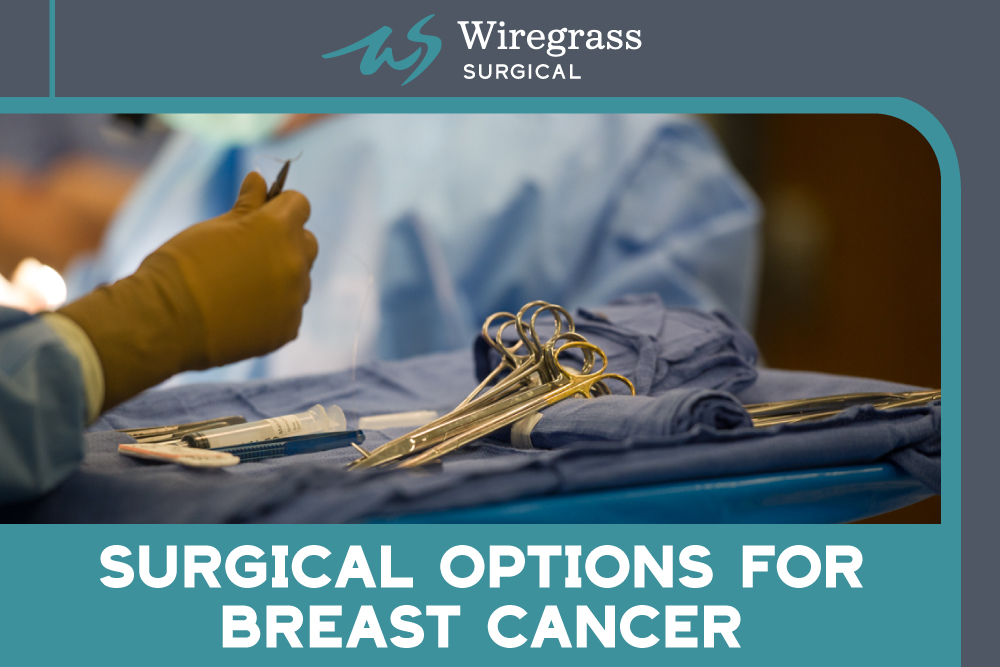
Breast Cancer and Surgery
One in eight women in the United States will develop breast cancer in her lifetime, making it the most common cancer in American women.
65% of cases are localized (meaning they don’t spread beyond the breasts), resulting in a 5-year survival rate of 99%.
Breast cancer happens when cells divide and grow out of control. Abnormal cells can grow within the milk ducts only, or deeper in the breast tissue (invasive breast cancer). When invasive breast cancer spreads to other organs in the body, it is defined as metastatic breast cancer.
If you or someone you know has recently been diagnosed with breast cancer, treatment will vary depending on the type and stage of cancer that you have. But today we want to discuss the surgical options for breast cancer.
The general surgeons at Wiregrass Surgical specialize in the diagnosis and treatment of breast cancer. Our approach is comprehensive and collaborative as we team up with some of the best pathologists, oncologists, radiologists and plastic/reconstructive surgeons in the state to create personalized plans for each of our patients going through treatment.
What is breast cancer surgery?
If you have localized breast cancer, surgery is almost always recommended and considered the best way to remove the affected tissue. Our general surgeons perform lumpectomies and mastectomies to remove cancer.
A lumpectomy removes an individual tumor from your breast whereas a mastectomy removes the entire breast(s), and all breast tissue, to remove the cancer. Although surgery is the primary treatment for breast cancer, it can also be an effective way to look for signs of cancer spreading. And sometimes it involves breast reconstruction after a mastectomy.
Mastectomy is the most common surgery for breast cancer because it treats both late-stage and early-stage cancers.
There are many different types of surgery including:
- Total mastectomy: removal of the entire breast, and breast tissue
- Double mastectomy: removal of both breasts, and breast tissue
- Skin-sparing or nipple-sparing: removal of all breast tissue but sparing the skin and/or nipple to help with reconstruction
- Modified radical mastectomy: removal of the breast tissue and underarm lymph nodes
- Radical mastectomy: removal of the breast tissue, underarm lymph nodes and chest muscles
A lumpectomy, or breast-conservation surgery, removes only the part of your breast tissue that contains the cancer, as well as some surrounding normal breast tissue, and is usually best for treating earlier-stage cancers.
Lumpectomy procedures include:
- Excisional biopsy: a procedure to remove a tumor for biopsy
- Wide local excision: surgery to remove a cancerous tumor and margin of tissue around it
- Quandrantectomy: segmental mastectomy to remove the duct-lobular system when the tumor shows ductal spread
Your surgery will depend on many individual factors including:
- The type of breast cancer
- What stage
- Your general health
- Personal preferences
The goal of treating breast cancer is to destroy the cancer cells and stop them from coming back.
Our surgeons at Wiregrass Surgical will be a part of your healthcare team that will decide the type of surgery that is best for you. If you’re interested in breast reconstruction during or after surgery, we can discuss these options for you as well and help coordinate that with a plastic surgeon. You can sometimes have this done the same day, or you may choose to delay this until after your chemotherapy.
What can I expect after surgery?
Depending on how extensive your surgery is, it can usually be done between 1-3 hours. You may have to stay in the hospital for a couple nights afterward, depending on your general health.
You may be sore and experience limited movement in your arms and chest for a few weeks, but most people can resume normal activities within one month.
Depending on your case, after surgery our surgeons may be waiting on your lymph node biopsy results to make sure they’ve removed all the cancer cells. Once these results are back, they will discuss next steps which may include follow-up surgery, radiation, chemotherapy or reconstruction.
Other services at Wiregrass Surgical
Besides breast cancer surgery, our practice also offers genetic testing and complimentary hereditary cancer risk assessments. We believe early detection improves survival rates and we are committed to helping all of our patients through the process of breast cancer treatments from prevention and diagnosis, to surgery, recovery and beyond.
To learn more about genetic testing, give us a call today!
Learn more about breast cancer treatments and set up an appointment today.
